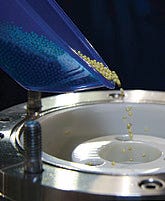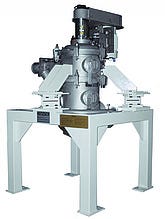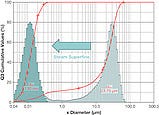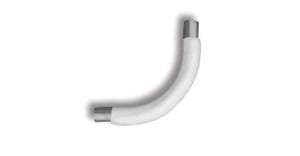May 6, 2010
By Becky Shemanski and Stephen Miranda
|
Media is added to the LabStar mill at Custom Processing Services’ toll processing plant in Reading, PA. |
Nano-sized particles are desirable in many industries, from active pharmaceuticals and pigments to technical ceramics and electronics, and are used to improve reactivity, provide increased surface area, and reduce material consumption.
Traditionally, producing sub-micron sized particles has only been possible through wet media milling. Recent developments in particle reduction technology have enabled the production of nanoparticles through a dry-grinding method using steam. Considering the advantages and applications of each method described below will enable the client to choose the most appropriate method and equipment to achieve the desired results.
Wet media milling employs a media mill charged with small spheres or beads and activated by a high-speed agitator shaft to create mechanical hydraulic shearing and particle impact. In agitator bead mills, the forces tear apart the solids suspended in a liquid (slurry) as they are pumped through the grinding chamber. The slurry is ready for use in liquid blends or if necessary is dried and separated for further use.
Depending on the material to be ground and the objective or end-use of the resulting product, one of two types of media milling processes may be chosen. In comminution, particles are ground within the slurry by high pressure shearing and impact forces to break apart the actual particles. In de-agglomeration, the small particles that are joined together are broken apart and separated. In some cases, both comminution and de-agglomeration are used on a single product.
Factors influencing the ultimate particle size are the size of the grinding media used, the material’s residence time (time spent in the grinding chamber), number of passes through the mill, and the speed of the agitation.
|
Netzsch s-Jet mill without insulation |
Advantages to Wet Media Milling
There are many advantages to wet media milling. The primary reason to select media milling is that the process can produce uniform particle size distribution in the micron and submicron (or nanometer) range. Also, dry-milled materials that have the tendency to agglomerate when added to liquid may avoid agglomeration by being mixed with a liquid and processed in a wet media mill. Wet milling will encapsulate the dry particle, surrounding it with liquid and preventing re-agglomeration. Further stabilization of the suspension using either electrostatic charge control or long-chain molecules can be achieved. Additionally, researchers have found that some materials exhibit dramatically changed physical properties when they are reduced to nanoparticles.
For example, organic pigments, when processed to sub-micron sizes, offer greater color strength than those produced by conventional grinding to one or two microns. This allows the client to use less pigment in an ink, paint, or dye, thereby reducing production costs. Other applications well-suited to wet milling include pharmaceuticals, nutraceuticals, and technical ceramics.
|
Shift supervisor John Harvey adds media to the LabStar mill at Custom Processing Services' Reading, PA facility. |
Despite its wide range of applications, wet media milling is not recommended in every instance. When a dry product is needed, the drying and de-agglomeration steps following wet milling add time and cost to the finished product. Additionally, contamination of the product may be introduced through media milling and its subsequent processes.
Advances in Dry Milling
In the past, manufacturers were simply unable to produce sub-micron particle sizes through dry milling methods. Now, when wet media milling is not desirable, it is possible to achieve nano-sized particles through jet mills operated with steam.
For example, Netzsch-Condux has developed a patented steam-operated fluidized bed jet mill that is capable of producing a dry powder with a d50 of less than 200 nanometers in a single step. This is possible because steam can be supplied at much higher temperature and pressure than air, providing the mill’s nozzles with increased velocity and greater impact energy. The physical properties of steam in a fluidized bed jet mill allows the machine’s internal air classifier to deliver particle size distributions in the sub-micron range.
|
PSD results for steam jet milling using Netzsch equipment |
An advantage of steam- operated milling is that it provides a much higher process efficiency compared to conventional air jet milling and can produce finer particle size distributions. In comparison to wet milling, steam jet milling eliminates the need for drying and de-agglomeration, yet still produces nanoparticles.
On the other hand, steam jet grinding cannot be used for products that are sensitive to high temperatures, such as active pharmaceuticals and organic materials.
However, any inorganic material not adversely affected by high temperatures, and where fine particle sizes are desired, may be suitable for steam-jet milling. Extensive testing has been performed on aluminum oxide, barium titanate, ceramic pigments, glass frits, graphite, rice ash, silicon carbide, talcum, and zirconium oxide.
In some cases, steam jet milling is more energy-intensive than media milling and its use would add additional costs to the product. Although many materials are suitable for steam jet milling, some substances cannot withstand the heat of the process. And when the finished product is needed to be wet or in a solution, it may be more cost-effective to reduce its size using wet media milling rather than steam jet milling.
Fortunately, there are contract manufacturers and equipment manufacturers that are well-versed in both wet and dry grinding. They can work with the client to arrive at the optimal selection of process and equipment.
Becky Shemanski is communications director, Custom Processing Services Inc. (Reading, PA), a contract manufacturer, specializing in micronizing, who offers both wet media milling and dry grinding, including air and steam jet milling.
Stephen Miranda is director of sales, Netzsch-Condux (Exton, PA), a manufacturer that offers a complete line of wet and dry grinding machinery and systems. For more information on Custom Processing Services Inc., visit www.customprocessingservices.com. For more information on Netzsch-Condux, visit www.netzsch.com.
You May Also Like






